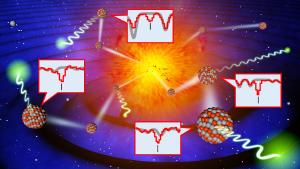Blog
Evolving Lines
10 January 2020
 NAOJ, University of Tokyo
NAOJ, University of TokyoAt the dawn of the universe, there was only hydrogen and helium. These elements made up all the galaxies and all the stars. But stars fuse hydrogen and helium into heavier elements, and large stars explode when they day. Their remnants form into new stars. The collisions of white dwarfs and neutron stars can create supernovae, which also toss heavy elements into deep space. Over time the chemistry of a galaxy becomes more rich and complex. By studying these elements we can understand how galaxies evolve.
The chemical composition of a star can be studied by observing the spectral lines of a star. Each type of element and molecule has a unique pattern of spectral lines that allows us to identify them. In optical astronomy, this has been done for more than a century. Stars can be classified by the amount of carbon, oxygen, and iron they contain.
Although the visible spectral lines of the elements are well established, infrared spectral lines are less known. We haven’t had high-resolution spectroscopy in the infrared until recently, so our infrared catalog is not as large. But this month a team from Japan has increased that catalog.1
Using a high-resolution infrared spectrograph known as WINERED, the team observed the spectra of 13 giant and supergiant stars. From their spectral line data, they identified 9 elements heavier than iron. This is an important discovery, since elements heavier than iron aren’t produced in the main sequence lifetime of a star. Instead, they are produced during cataclysmic events such as the collapse of a star’s core, or during stellar collisions. Observations such as these add a new piece to the puzzle of stellar evolution.
There is still significant research to be done with infrared spectra. This new work shows, however, that infrared line spectra could prove to be just as important as the line spectra of visible light.
Matsunaga et al. “Identification of Absorption Lines of Heavy Metals in the Wavelength Range 0.97-1.32 μm” Astrophysical Journal 2020. ↩︎